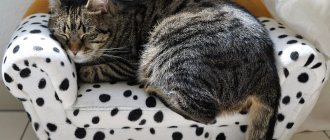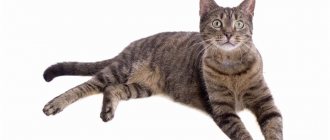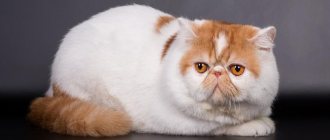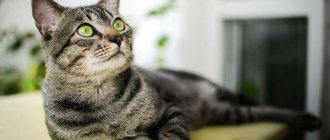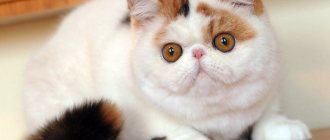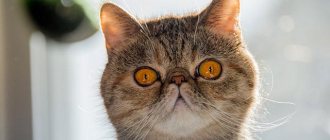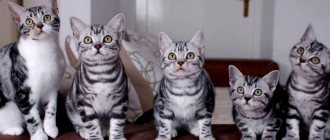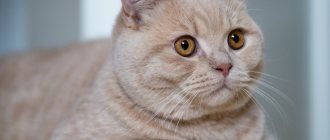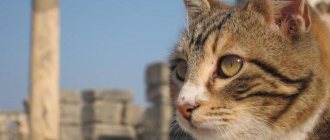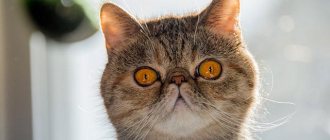The European cat is a short-haired breed with pronounced hunting instincts. It is generally accepted that it was this breed that was first domesticated and began to live in the home of an ancient person.
To emphasize the historical origin of the animal, the association of felinologists WCF assigned the name Celtic Smoothhair to the breed. But the new terminology did not take root among owners and breeders.
Origin story
The European Shorthair breed is recognizable and popular no less than the British one. The progenitors of this breed include both wild European and Nubian breeds, but the historical component remains a mystery to this day, shrouded in darkness. The following is known for sure: for the first time a representative of this breed was presented in 1938, at an exhibition in Berlin. The beautiful Wastl von der Kohlung, a large, dignified silver-merle cat, amazed the audience.
However, they did not want to register these cats as a separate breed for quite some time. They were classified as British, and accordingly, the appropriate standards were used.
Most of the representatives of the “Europeans” simply stopped breeding over time, but British cat lovers did not want to give up. In an effort to improve the breed - to make the undercoat thicker, to preserve small ears and head, but to increase the massiveness of the body and make the animal stronger - they continued the selection work.
In 1982, the world-famous FIFe divided the breeds, introducing one standard for “British” and another for “European”.
There is another name for the breed - Celtic Shorthair. It indicates the Scandinavian origin of these cats.
What are the advantages and disadvantages of the European Shorthair cat breed?
This cat has adapted well to the demands placed on humans. For business people who do not have enough time to painstakingly care for a cat, the most reasonable thing would be to focus their attention on this breed.
Table: comparative characteristics of the Celtic cat breed
| Advantages | Flaws |
| Relatively low cost of a kitten. | Simple appearance, very close to the appearance of non-pedigreed cats. |
| Undemanding in care, nutrition and maintenance. | Low popularity of the breed in Russia. |
| High level of health. | Lack of nurseries in the country. |
| Friendly character, good attitude towards children and other family members, ability to be alone. | |
| Quickly masters the litter tray and other rules of behavior in the house, cleanliness. | |
| Has the instincts of a good hunter and can protect the house from rodents. |
Standards
Externally, European shorthair cats resemble the familiar “Barsiks” and “Murziks” running around the streets, the so-called classic domestic cats. Males are large and strong, sometimes weighing 8, or even 9, kilograms. Females are smaller, with an average weight of 4.5-5 kg.
| Standard | Description |
| Head | Large, with a round and long muzzle. The forehead is rounded, like the skull. The nose is smooth, of medium length, with a noticeable dimple at the transition to the forehead. The chin is clearly defined, strong, strong-willed. The neck is of medium length. The cheeks are slightly protruding, round, well-fed. |
| Eyes | Round, slightly slanting, wide open. The iris can be painted in any color (heterochromia is also allowed, i.e. one eye is amber, the other is light blue), but the color must be uniform. |
| Ears | Medium size, with rounded ends. Some individuals have small tassels growing on their ears. They stand vertically, at a short distance from each other. |
| Torso | Powerful, with well-developed muscles. The chest is round and well developed. |
| Limbs | Medium length, strong, proportionally developed. The paws are round, the pads are elastic, pink or gray. |
| Tail | Thick at the base, tapering towards the end. The tip is rounded. |
| Wool | Shiny, elastic and thick. It is hard to the touch and fits tightly to the body. |
The following are considered defects of the breed: sagging cheeks; clear “stop”; presence of genes from other breeds; short, weakly defined chin; broken crooked tail; too long coat.
Health
Because of their roots, European Shorthair cats have almost no health problems, and genetic diseases do not bother them at all. To prevent infectious diseases, you need to undergo routine vaccinations against fleas, ticks, and helminths, and also take your cat to the veterinarian.
- Vaccinations: the first vaccination of major diseases is carried out at 3-4 months, the second – after another three weeks. Next, you need annual revaccination of adults, as well as a rabies vaccination once every 3 years.
- Treatment against parasites: shampoos, sprays, drops on the withers, collars. They are used at the first signs of infection, when the cat begins to scratch restlessly, especially in the ear area.
- Fight against internal parasites, once every six months for prevention or before significant events in the pet’s life (exhibition, vaccination, mating).
European shorthair cat
Exhibition specimens are subject to much more health requirements. Thus, deviations from the standards of the European Shorthair breed include:
- a wide muzzle as a sign of the British branch of selection;
- tail creases;
- white spots in the color (accepted only as the main color);
- saggy cheeks;
- weak chin;
- too long and soft wool.
Colors
The color palette of the European Shorthair cat is rich in shades. The following are allowed:
- Tricolors: tortoiseshell (including bluish-cream, chocolate, lilac, white shades);
- Marble: lilac-silver, chocolate-silver, silver with blue or black, chocolate, black, blue, red, cream;
- Tiger (shades like marble ones);
- Bicolors: white combined with black, cream, red, blue, chocolate, lilac);
- Spotted: there are 2 dozen options;
- Shaded (veiled) black, blue, lilac, red, smoky, cream, white with orange or blue eyes.
The photo shows a cat of the European Shorthair breed, colors: bicolor, brindle, marbled.
Currently, more and more breeders are interested in breeding cats with unusual colors: golden and silver. But point colors, so popular among the “British,” are not recognized among the Celts. Official communities believe that since this breed is native, unnatural colors should not be introduced into it.
Interesting Facts
- the oldest cat breed in the world is at the same time the youngest in the FIFe classification, because the European Shorthair received official recognition only in 1982;
- there are many names for these cats depending on the geography of origin and breeding: European shorthair (smooth-haired), European longhair, Eastern European cat, Swedish, Celtic;
- a cat of this species is more of a companion than a relative, due to its independent character and free disposition;
- on the scale of temperament, they occupy the golden mean: affectionate, but without intrusiveness, they have leadership inclinations, but not aggressive.
Character and behavior
Who knows, the European cat is ideal as a pet. She has a lot of positive qualities: flexibility, kindness, lack of aggression, friendliness. From the very first days of its appearance in the house, the animal chooses its leader and begins to literally copy his behavior, adopting the most striking habits, adapting to his regime and gradually turning into a smaller copy of him.
Cats of this breed have one funny feature: when they are very frightened, their paw pads, ears and nose become bright pink. Have you noticed that your pet is blushing? Calm her down quickly!
“Europeans,” while firmly attached to the leader, do not ignore the rest of the family. Quite the opposite: all household members will receive a portion of the cat’s attention and affection. Cats are especially drawn to children: they willingly play chase and hide-and-seek with them, lick their hands and feet, and go to sleep in the same bed with them. And even if the baby hurts the cat, they will not try to bite him, much less take revenge in the future. That is why “Europeans” are so popular in large families.
“Europeans” are playful, but they are also great at entertaining themselves. Buy your cat a few toys and he won't bother you unless you're in the mood to race around the apartment.
Are a cat's pupils the same during the day and at night?
Not really
“Europeans” quickly find a common language with other animals: in any case, they can easily make friends with cats and dogs. But hamsters, rats, guinea pigs and small birds are a source of danger for them. More precisely, not even for them: “Europeans” classify them as pests and do their best to protect household members from their presence in the apartment. In addition, cats of this breed have a well-developed hunting instinct, so be prepared that your little predator will often be “active” at night, running around rooms and dropping objects.
“Europeans” rarely raise their voice – only if something out of the ordinary happens. They often prefer to communicate with their eyes.
They are smart and understanding, so your task is to accustom the kitten to order from an early age. Eat in one place, sleep on a separate bed, walk on a leash. Speaking of walks: European Shorthairs are not afraid of cars or other people, so you can go for walks with them from time to time. But you shouldn’t practice free walking: curiosity can lead a cat too far from home.
Expert opinion
Dusheba Vera Ivanovna
In 2010, she graduated from the Moscow State Academy of Veterinary Medicine named after K.I. Scriabin with honors, specializing in veterinary medicine. I regularly attend veterinary conferences, congresses, and webinars.
Unfortunately, there are no nurseries in Russia that specialize in raising this particular breed. Therefore, you can buy a kitten either from private breeders or abroad. The price depends on how many titles his father and mother had, as well as on the class of the baby itself, and varies from 2 to 15 thousand rubles from a private person, and from 25 to 45 thousand rubles from a foreign nursery (plus delivery).
Take a kitten at the age of 3-4 months: by this age the baby will be taught to eat and go to the litter box on his own (read the article on the topic How to train a kitten to use the litter box?), will be given the necessary vaccinations, and it will be easier for him to adapt. Choose a strong and healthy baby: with clean ears and eyes, shiny and thick fur. The animal must not be aggressive or slaughtered. The following documents must be present: a kitten’s passport indicating its name, date of birth, information about parents and vaccinations; contract of sale.
How to breed a European Shorthair cat
When starting to breed a breed, remember that the first mating is the most important. For cats of this breed, it is best to carry it out during the third heat cycle, that is, at about one and a half years. A month before mating, it is necessary to undergo an examination by a veterinarian, receive vaccinations, if necessary, and undergo deworming.
In order for your cat’s offspring to be highly valued in the feline society, she must first participate in some cat shows
If your pet has been awarded the champion title, you immediately acquire a high rating in the field of breeding. But even in case of failure, all exhibitors receive an assessment based on the level of value of the animal for breeding. Based on this criterion, you select a worthy partner for your pet in advance. In this case, you need to take into account:
- in the WCF and FIFE exhibition systems, breeding work, including the search for partners, is carried out only through the club; in order to engage in breeding, you must be a member of any club that unites cat breeders;
- in the American exhibition system TICA and CFA, breeders are responsible for the result of their work, and it is not necessary to be a member of a felinological club.
If all the organizational part is completed, on the third day of estrus you take the cat to your partner and leave him there for several days. The cat owner will take care of your pet during this time and supervise the mating.
The act of mating is confirmed by a document indicating the following information:
- details of partners, their titles and pedigrees;
- information about the owners;
- mating conditions;
- time spending.
The document is drawn up in two copies, and copies of the pet owners’ passports are added to it.
What a cat owner needs to consider
The first mating of a cat is carried out at its full sexual maturity, which occurs after about a year and three months. Usually, young cats are looking for more experienced partners.
Mating is carried out on the male's territory, so the owner must ensure the safety of the animals throughout the entire period. Ideally, the cat has a fenced-off enclosure, in which there are no breakable or breakable objects, it is impossible to hide in any crevice, and a protective mesh is installed on the windows.
Payment is made by agreement and usually after a confirmed pregnancy.
Care instructions
Caring for a European Shorthair cat is not as difficult as, for example, a Persian or Oriental. But the basic rules remain the same.
Eyes
Examine your pet's eyes once a week and remove any discharge, if any. It's simple: moisten a cotton sponge (you shouldn't use cotton wool - inflammation can develop if particles get on the mucous membrane) in a special eye lotion (or a fresh decoction of chamomile, or plain boiled water) and gently blot the corners of the eyes.
Ears
The ears of “Europeans” are large and almost smooth from the inside, so dust and dirt accumulate in them in excess, not to mention wax. They also require weekly cleaning using a special solution and cotton swabs.
But be careful! Any careless movement can lead to injury and inflammation. Do not try to insert the stick into the ear canal itself; clean only the visible part of the ear. Don't put anything inside!
Wool
Care also includes brushing - at least once a week - with a brush with natural bristles. You can bathe a “European”, but every week. Frequent bathing leads to the fact that the animal begins to suffer from dermatitis, and its coat loses its natural shine. Bathing is necessary before the exhibition, if the cat is very dirty or before giving birth. Use special shampoo: “Bars”, “Doctor ZOO”, Iv San Bernard “Lemon”.
Teeth
Regular brushing will help keep your teeth healthy and strong. Since the animal is not able to do this, you, as the owner, will have to do it yourself. Buy a soft brush (soft silicone or with natural bristles) and a special toothpaste (Trixie, Beaphar Toothpaste, Hartz) from a veterinary pharmacy, and brush your cat’s teeth several times a month. In addition, take your cat to the veterinarian once a year for an oral health check.
For some Celtic cats, such a procedure as brushing their teeth turns into real torture. The animal becomes so stressed that it breaks out and tries to bite and scratch.
To make the task easier, a dental spray (Sentry Petrodex Dental Spray, Api-San Zubastik, Beaphar Fresh Breath Spray), water additives (TropiClean Water Additive Original, Cliny) or snacks (Mnyams Healthy Teeth, GimCat Denta-Kiss) will help , Beaphar Cat-a-Dent Bits.
Claws
The “European” is good at sharpening his claws himself, but your task is to buy him a strong and comfortable scratching post, and trim his claws with a nail clipper once a month.
The photo shows a cat of the European Shorthair breed, tricolor color
Catering
The owner has the right to choose what he will feed his pet: natural food or prepared food. European shorthair cats do not require any specific nutrition and are not prone to overeating, which means that they are not at risk of obesity. But the owner should remember some rules.
Holistics
When choosing industrial food, take into account the individual needs of the pet, its physical characteristics: age, health, weight. Holistics are considered the best in quality. These foods use fresh and dehydrated meat, fish fillets, natural preservatives, berries, fruits and vegetables. In addition, it contains a good vitamin and mineral supplement. Examples: Acana, Wildcat, Pronature Holistic.
Super premium
Super premium food is in second place and differs from holistic food in the smaller amount of meat. However, the amount of meat, meat ingredients, vegetables and nutrients in general allows you to use these foods without fear. And they are cheaper than holistic feeds. Examples: Brooksfield, Guabi Natural, Arden Grange.
Premium and Economy
Premium and economy food are cheaper than those mentioned above, but they practically do not receive approval from cat owners. They most often contain meat waste (bones, skin and tripe, not meat), allergy-causing wheat and corn, vegetable proteins, antioxidants and preservatives of unknown origin. Premium food samples: Eukanuba, Night Hunter, Safari. Economy group foods include Whiskas, All Cats, Perfect Fit.
Below are recommended super-premium and holistic foods. Links with the names of the food are clickable, on them you can, within our website, get acquainted with the descriptions of the food and read reviews from owners of European Shorthair cats.
| Premium | Super premium | Holistic |
| Wahre Liebe | Natyka | Farmina N&D |
Natural products
From natural products it is allowed to give:
- Frozen fresh beef (for a kitten - from 30 grams, for an adult animal - 100-120 grams) is given at least 3 times a week.
- Chicken, turkey, veal, and rabbit meat (in the same quantities) are given 2-3 times a week.
- By-products (ventricles, kidneys, hearts, liver, necks) - 2-3 times a week. Raw or cooked (the liver must be boiled).
- Sea fish (hake, salmon, trout, salmon, cod) - no more than once a week. Excess fish leads to the formation of kidney stones, in addition, it impedes the absorption of vitamin B.
- Fermented milk products (medium fat kefir, cream, sour cream, fermented baked milk, Varenets, cottage cheese, natural yogurt) can be given daily. They should not contain dyes or harmful components.
- Boiled chicken and quail eggs (from chicken eggs - only the yolk) - 1-2 times a week.
- Cereals (millet, rice, oatmeal, buckwheat, pearl barley) – 5 times a week.
- Stewed, boiled or raw vegetables (pumpkin, carrots, zucchini, green beans, cauliflower), as well as greens (spinach, lettuce, dill) are added to porridge.
- Brewer's yeast (dry) - according to instructions.
- Vegetable or olive oil - 3-4 drops in porridge.
- Vitamin supplements - in agreement with the veterinarian.
Sprouted grains of wheat or oats - a container with grass is placed in a convenient place, and the cat feasts on it at will.
Clean water should always be poured, purified and at a comfortable temperature for drinking. You cannot give your animal juices, mineral water, tea or other human drinks.
You cannot give:
- Offal, skin, bones, lard;
- Lamb, pork, goose and duck meat;
- Sweets, baked goods, flour, smoked, salty, sour;
- Human canned food, sausages and frankfurters;
- Salt, sugar, spices, sauces, mayonnaise;
- Potatoes, beans, avocados, tomatoes, eggplants;
- Vitamins and supplements for people.
Kittens up to 3 months eat 6 times a day, up to six months - 3-4, older - 2 times. An exception is made for animals weakened after illness; cats bearing and feeding offspring; older animals.
The photo shows kittens of a European shorthair cat
